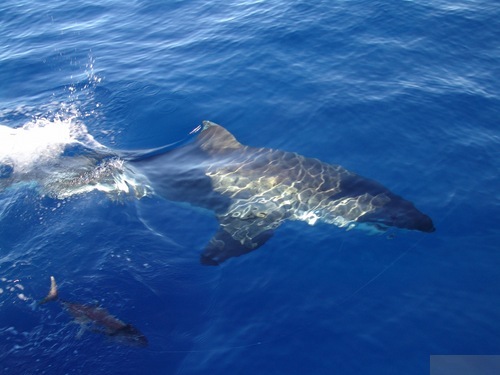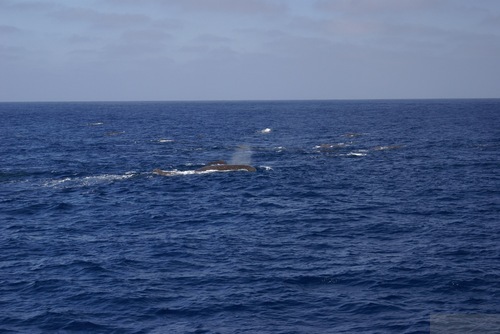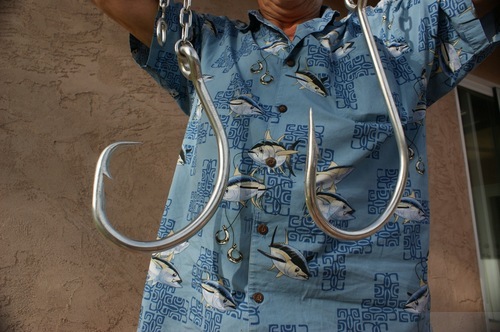Long Range Fish Report
From Sportfishing
From Sportfishing
Fish Report for 3-8-2010

White Sharks Eat Giant Squid?
3-8-2010
Bill Roecker
Long range anglers sometimes have it tough at Guadalupe Island, when at least two dozen white sharks of 12 to over 20 feet in length are known to frequent the lee side during summer. Sometimes they become temporarily focused on hooked yellowfin tuna. Skippers have little choice but to move when the sharks zero in on fish brought to the boat.
To onlookers, it appears the sharks just hang out under the hull until they see an easy meal. I got footage of a 20-footer with blue hull paint from the Excel on its tail and dorsal fin just a few years ago, while shooting the DVD "White Sharks and Tuna." The opportunistic whites like the big yellowtail of Guadalupe, too, we discovered.
Well-known angler-conservationist Tom Pfleger of PIER and Dr. Michael Domeier of the Marine Conservation Science Institute of Fallbrook are among those active in tagging and studying the sharks, and Mustad recently developed some giant hooks specific for the purpose of bringing the monsters in for archival tagging, reported here at FishingVideos.com.
Michael Dormeier was featured in a lengthy interview with me when he operated an Oceanside facility for studying giant black sea bass in 1998. That interview was featured in the video "Breaking Bluefin," which I made in 1999. Not long after, the City of Oceanside showed a remarkable lack of foresight by denying Pfleger permission to build a 10 million-dollar, open to the public, aquarium-research project because of parking issues.
According to a story in the March 7 issue of the LA Times by Jill Leovy ("A Food Fight For Leviathans," p A37), the sharks seem to be migrating annually from mid-ocean to both Guadalupe and the Farallon Islands off San Francisco. They're known to feed on elephant seals, fur seals and sea lions at these islands, but they may also be breeding. Some big females don't come to the islands, though, so maybe they breed out there in the deeps.
The white sharks main living area seems to be between Hawaii and southern California, as tag tracking indicates. Why would they hang out there? Domeier thinks it may be because they like eating giant squid. We're not talking about those little six-foot Humboldt squid that plague the west coast, but the true giants of 20 to who-knows-how-big squish that have been found up to at least 50 feet in length. They probably get larger.
Sperm whales are about the only other known predators of giant squid, but orcas may eat them as well. It may be no coincidence that sperm whales were seen leaping at the mid-ocean squid haunts.
The recent studies seem to show that great white sharks don't spend their time roaming beaches in search of surfers or swimmers to eat. They like eating hooked tuna and seals, which is obvious to Guadalupe anglers. That these huge opportunistic hunter-scavengers may chew on giant squid is something new, and it makes me wonder if they're assisted by the activities of the sperm whales. Maybe they hang out near the whales and pick off the pieces, the tentacles, etc, during what we think of as epic battles in the deep ocean. Or maybe they attack the giant cephalopods on their own, successfully.
It's all speculation now, of course. Hopefully we'll learn a lot more after the shark studies mature with much more data collection over the coming years.
To onlookers, it appears the sharks just hang out under the hull until they see an easy meal. I got footage of a 20-footer with blue hull paint from the Excel on its tail and dorsal fin just a few years ago, while shooting the DVD "White Sharks and Tuna." The opportunistic whites like the big yellowtail of Guadalupe, too, we discovered.
Well-known angler-conservationist Tom Pfleger of PIER and Dr. Michael Domeier of the Marine Conservation Science Institute of Fallbrook are among those active in tagging and studying the sharks, and Mustad recently developed some giant hooks specific for the purpose of bringing the monsters in for archival tagging, reported here at FishingVideos.com.
Michael Dormeier was featured in a lengthy interview with me when he operated an Oceanside facility for studying giant black sea bass in 1998. That interview was featured in the video "Breaking Bluefin," which I made in 1999. Not long after, the City of Oceanside showed a remarkable lack of foresight by denying Pfleger permission to build a 10 million-dollar, open to the public, aquarium-research project because of parking issues.
According to a story in the March 7 issue of the LA Times by Jill Leovy ("A Food Fight For Leviathans," p A37), the sharks seem to be migrating annually from mid-ocean to both Guadalupe and the Farallon Islands off San Francisco. They're known to feed on elephant seals, fur seals and sea lions at these islands, but they may also be breeding. Some big females don't come to the islands, though, so maybe they breed out there in the deeps.
The white sharks main living area seems to be between Hawaii and southern California, as tag tracking indicates. Why would they hang out there? Domeier thinks it may be because they like eating giant squid. We're not talking about those little six-foot Humboldt squid that plague the west coast, but the true giants of 20 to who-knows-how-big squish that have been found up to at least 50 feet in length. They probably get larger.
Sperm whales are about the only other known predators of giant squid, but orcas may eat them as well. It may be no coincidence that sperm whales were seen leaping at the mid-ocean squid haunts.
The recent studies seem to show that great white sharks don't spend their time roaming beaches in search of surfers or swimmers to eat. They like eating hooked tuna and seals, which is obvious to Guadalupe anglers. That these huge opportunistic hunter-scavengers may chew on giant squid is something new, and it makes me wonder if they're assisted by the activities of the sperm whales. Maybe they hang out near the whales and pick off the pieces, the tentacles, etc, during what we think of as epic battles in the deep ocean. Or maybe they attack the giant cephalopods on their own, successfully.
It's all speculation now, of course. Hopefully we'll learn a lot more after the shark studies mature with much more data collection over the coming years.
Photos
< Previous Report Next Report >
More Reports

3-8-2010
San Diego's long range fleet is in port this week. At this time of year it's normal for the boats...... Read More
Fishing Videos Reports
for Tuesday, March 2nd, 2010• Izorline Trip Back With A Blue Moon Story
• It’s Showtime! Bring The Kids
• Now That’s A Hook!

LongRangeSportfishing.net © 2025. All Rights Reserved.
Website Hosting and Design provided by TECK.net
Website Hosting and Design provided by TECK.net

